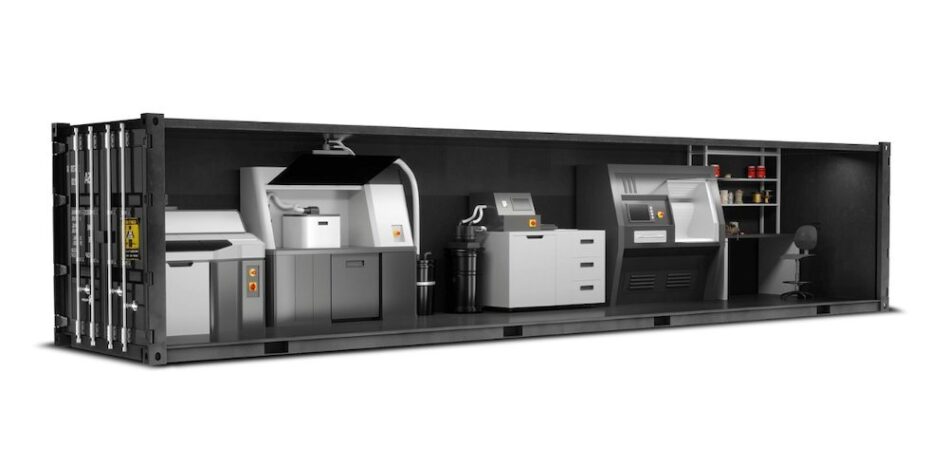Well, turns out Firestorm Labs is printing a lot more than drones. On Wednesday, the San Diego-based manufacturing and drone company announced it has raised a $47M Series A led by New Enterprise Associates (NEA), with participation from Lockheed Martin Ventures, Decisive Point, Washington Harbour Partners, Booz Allen Ventures, and others.
The company says it will use the funding—which includes $12M in venture debt from J. P. Morgan—to expand into a new facility, double the size of its team, and build up both its xCell “factory-in-a-box” manufacturing and drone offerings.
Tectonic chatted with Firestorm CEO Dan Magy about the raise, why mobile manufacturing is so critical, and what comes next for the start-up.
Back it up: For a bit of context, Firestorm was founded in 2022 and has made a name for itself 3D-printing attributable, modular drones and mobile manufacturing units designed to build them—and fast.
Back in January, the company was awarded a $100M IDIQ with the Air Force (which Magy said is signed and in progress) and earlier this month announced a partnership with HP—which means Firestorm is now the “sole provider of HP’s high-performance 3D printers in mobile and field-deployable environments.”
Currently, the company makes two 3D-printed drones:
- Tempest: A modular drone with a 7-ft wingspan that can be broken down and transported in a case. It can be configured for reconnaissance, strike—whatever you please, as long as the payload is under 10lbs.
- El Niño: A teeny-tiny hand-launched miniature precision-guided system (mPGS), basically a smart munition, that provides accurate fires and can be set up in about 30 seconds, according to the company.
The company also produces ready-to-go mobile manufacturing units called xCell.
- The units are basically shipping containers kitted out with everything you’d need to print these drones—or any other part you need.
- According to Firestorm, they come in two form factors: two 20-foot containers or one 40-foot container.
- The manufacturing units can function autonomously using generator power and are ruggedized and designed to work in remote and way off-the-grid locations.
- Right now, the units have a 50 drone/month production capacity
- They can print parts up to two feet in size—but Firestorm designers can break down larger parts into smaller bits to print those, too.
Magy told Tectonic that there are “dozens” of these units under construction right now, but couldn’t tell us where they’d been deployed (yet).
Building blocks: Magy said that with the new injection of cash, his company plans to double down on manufacturing. When his team speaks with folks inside the DoD—and in allied defense ministries around the world—he said that one of the greatest needs they have is for manufacturing and component production at the frontline.
“Everything we’re hearing is like, focus on manufacturing, figure out how to do it at the edge, because it really solves a lot of the contested logistics issues that we currently face,” he said.
With one of Firestorm’s units, Magy said, you can print parts for any kind of equipment when it breaks—even if the kit isn’t made by Firestorm.
Of course, there are all sorts of IP hoops to jump through for copyrighted stuff, but Magy said they’re exploring partnerships for that. And they can start work on stuff where IP has expired right away.
“We recently helped a branch of the military [that has] been waiting on a six-month lead time on a part. We printed 300 of these parts and gave them to them for an exercise, because [it] was limiting ground vehicles from being available,” Magy said, “This is a part that breaks all the time, [but] it costs $1,500 and it takes six months to deliver. That’s unacceptable.”
Right now, the company is exploring new print materials—carbon fiber, metals, and ceramics among them—to be able to print even more critical components. He sees the xCell units as a critical step in solving a lot of the production and supply chain issues the military has—especially when looking towards a potential fight with China.
“We think Firestorm really helps…tip the balance of power, or build a hedge, in the Indo-Pacific and CENTCOM,” he said.
Droning on: Just because they’re amping up the manufacturing side of things, however, doesn’t mean the drone business is going anywhere.
“We have and continue to grow a massive drone team [and] a massive software team as well to support the drones. But we think that these two technologies go hand in hand,” Magy said.
The company is exploring new drone models, including a version of Tempest that has longer range, and a few models that “fill a gap in the attritable drone space.”

